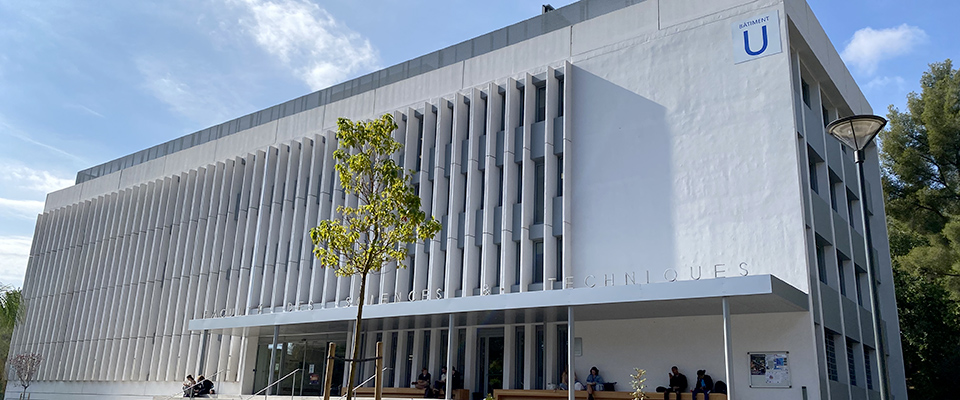- [M2] Y. Aubry (IMATH) Nombre de solutions d’un système de polynômes homogènes sur les corps finis.
On considère le problème de la détermination du nombre maximum de zéros communs dans un espace projectif sur un corps fini d’un système de polynômes homogènes à plusieurs variables linéairement indépendants définis sur ce corps fini. Il existe une conjecture élaborée de Tsfasman et Bogulavsky qui prédit la valeur maximale quand les polynômes homogènes ont le même degré et qui n’est pas trop grand par rapport à la taille du corps fini. On montre que cette conjecture est vérifiée si le nombre de polynômes n’excède pas le nombre total de variables. Cela étend les résultats de Serre (1983) et Bogulavsky (1997) dans le cas d’un et de deux polynômes, respectivement. De plus, cela complète nos résultats récents montrant que la conjecture est fausse, en général, si le nombre de polynômes excède le nombre total de variables. - [M2] P. Briet (CPT) Modélisation d’un guide d’onde torsadé.
Cf. ici - [M1/2] M. Ersoy (IMATH) A moving mesh method for hyperbolic equations.
The aim of this work is to study a moving mesh finite volume method for scalar (and system of) hyperbolic conservation laws. The basical numerical analysis questions such as stability, consistency and convergence of the numerical scheme will be considered. Besides theoretical framework, a numerical code (written in C, C++, fortran or other languages) will be developed and validated through several test cases. - [M1/2] G. Faccanoni (IMATH) Résolution analytique du problème de Riemann pour les équations d’Euler avec un gaz raidi.
On se propose de calculer analytiquement la solution exacte du problème de Riemann pour les équations d’Euler de la dynamique des gaz fermées par une loi d’état de type Stiffened Gaz. On comparera cette solution aux solutions approchées obtenues par divers schémas numériques classiques.
Prérequis: systèmes hyperboliques et lois de conservation, goût pour la modélisation et la programmation
Langages: python ou Scilab (Octave/Matlab) ou Fortran90 - [M2] G. Faccanoni (IMATH) Modélisation et calcul numérique du pouls sanguin.
On se propose de calculer analytiquement la solution exacte du problème de Riemann pour un système hyperbolique qui modélise de façon simplifiée le pouls sanguin. On comparera cette solution aux solutions approchées obtenues par divers schémas numériques classiques.
Mots clefs: équations aux dérivées partielles, volumes finis
Prérequis: systèmes hyperboliques de lois de conservation, goût pour la modélisation et la programmation
Langages: python ou Scilab (Octave/Matlab) ou Fortran90 - [M2] G. Faccanoni (IMATH) Modélisation et calcul numérique du coup de bélier.
On se propose de calculer analytiquement la solution exacte du problème de Riemann pour un système hyperbolique qui modélise les ondes de pression dans une pipeline. On comparera cette solution aux solutions approchées obtenues par divers schémas numériques classiques.
Mots clefs: équations aux dérivées partielles, volumes finis
Prérequis: systèmes hyperboliques de lois de conservation, goût pour la modélisation et la programmation
Langages: python ou Scilab (Octave/Matlab) ou Fortran90 - [M1/2] G. Faccanoni (IMATH) Simulation des équations de Navier-Stokes avec FreeFem++.
On s’intéresse à la simulation numérique avec FreeFem++ des équations de Navier-Stokes par différents schémas numériques.
Mots clefs: équations aux dérivées partielles, éléments finis
Prérequis: éléments finis, goût pour la modélisation et la programmation
Langages: FreeFem++ - [M1/2] G. Faccanoni (IMATH) Etude d’un modèle de turbulence avec FreeFem++.
On s’intéresse à la simulation numérique avec FreeFem++ des équations de Navier-Stokes fermées par un modèle de turbulence k-epsilon.
Mots clefs: équations aux dérivées partielles, turbulence, éléments finis
Prérequis: éléments finis, goût pour la modélisation et la programmation
Langages: FreeFem++ - [M2] S. Meradji (CPT/IMATH) Implementation of a LES-EDC model in a physics-based fire propagation model.
Cf. ici - [M2] S. Meradji (CPT/IMATH) Implementation of MIC-CG method for solving pressure equation in a 3D physics-based fire propagation model.
Cf. ici - [M1/2] A. Novotny (IMATH) Thermodynamic stability conditions and relative energy functional in compressible fluids.
The goal of the project is to reformulate the termodynamic stability conditions for weak solutions of compressible Navier-Stokes equations in terms of the so called relative energy inequality, and eventually to investigate some consequences of this formulation. - [M2] C.-A. Pillet (CPT) Géométrie de l’équation de Riccati matricielle.
Cf. ici - [M1] M. Rouleux (CPT) Modèle de Hubbard et spins à symétrie continue.
Cf. ici - [M2] M. Rouleux (CPT) Vorticité sur un groupe de Lie.
Cf. ici
Organismes de recherche extérieurs
- [M2] A. Beaudoin (Université de Poitiers) Modélisation numerique de la sédimentation dans une colonne d’eau au repos – Prise en compte de la granulométrie des particules.
Cf. ici
Entreprises
- [M2] SAFRAN – SNECMA Etudes d’influences sur des problèmes d’optimisation métiers pour réduction paramétrique H/F.
Cf. ici

